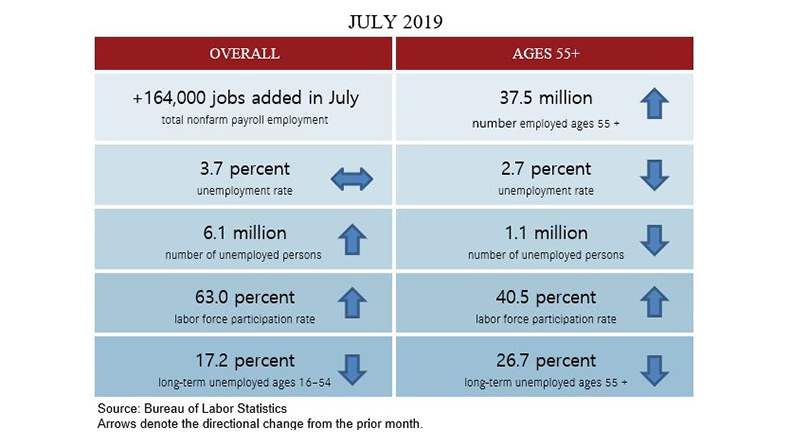AARP Hearing Center
Labor Force Participation Up and Unemployment Down for the 55+ in July
By Jennifer Schramm, August 2, 2019 04:20 PM

Employment Overview
The labor market added +164,000 jobs, according to the Bureau of Labor Statistics (BLS) monthly Employment Situation Summary. The overall unemployment rate was unchanged at 3.7 percent but was down for those ages 55+, from 3.0 to 2.7 percent. The number of people ages 55+ who were unemployed declined slightly to 1.1 million. The overall labor force participation rate edged up to 63.0 percent, and was up slightly to 40.5 percent for those ages 55+. In July, 26.7 percent of jobseekers ages 55 and older were long-term unemployed compared with 17.2 percent of those ages 16 to 54.
Spotlight: How common is re-careering among older workers?
Policymakers often view occupational change or “re-careering” as a strategy for workers to navigate a shifting labor market, in which automation and other forces are displacing workers. Yet research finds that overall the likelihood of re-careering declines with age, suggesting that older workers may face additional hurdles transitioning into new occupations.
Analysis of BLS data shows that age is the largest contributor to a worker’s likelihood of transferring to a different occupation. The probability that a worker will change occupations peaks at ages 18 to 19 and after that declines with age.
Education is another variable that appears to have a significant impact on the likelihood of changing occupations. Those with higher levels of educational attainment have greater occupational mobility than those with less education. Workers with lower levels of education may not have a broad enough skillset to successfully transition into a new occupation. In addition, while more highly educated individuals on average are more likely to change occupations, individuals in a few occupations characterized by very high levels of education may have little likelihood of occupation change. This is likely due to the highly specialized level of skill required for these occupations. Individuals working in jobs requiring advanced degrees are also likely to experience higher compensation rates, and good working conditions, and these may incentivize them to remain in their current occupation.
The data show that men are slightly more likely than women to change occupations. Changing occupations may be more common among men at older ages because when they leave a job in their fifties or sixties, they are less likely than women to leave the labor force entirely.
Research has shown that many later-life career changes are due to involuntary job loss and that these older career-changers experience a decline in pay in their new occupations. They are also less likely to have access to health benefits or pensions. More positively, some older career changers report they enjoy their work more than in their previous career and their new occupations often have more flexibility and less stress.
The data on occupational transfers suggest that re-careering is not currently widespread and older workers who move into a different occupation often pay a penalty in reduced earnings. Policymakers considering options for managing current and future job displacement caused by automation and other forces will need to be aware that data indicate there are disincentives to re-careering. Greater investments in learning and training will be especially important for those with the lowest skills and education levels if they are to transition successfully out of occupations with declining employment and into new and growing ones.
Find more details on the latest employment data in the July Employment Data Digest, PPI’s monthly review of job trends for those ages 55 and over. For more data to drive policy solutions, go to www.aarp.org/dataexplorer, and for information on skills, jobs, and occupations for the 50+, visit www.aarp.org/laborshortages.

Jen Schramm is a senior strategic policy advisor at the AARP Public Policy Institute. Her areas of expertise include employment trends, policy challenges and opportunities related to workers and jobseekers ages 50 and above, and skills and credentialing for mid- and late-career workers.































































